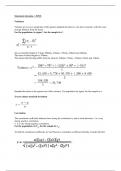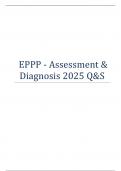Statistical formulas + SPSS
Variance
Variance gives you a rough idea of the spread, standard deviation is a lot more concrete, with the exact
average distance from the mean.
For the population, its sigma2 , for the sample its s2.
Say you had the height of 5 dogs: 600mm, 470mm, 170mm, 430mm and 300mm.
The mean of these heights is 394mm.
This means that the dogs differ from the mean by 206mm, 76mm, -224mm, 36mm and -94mm.
Standard deviation is the square root of the variance. For population its sigma, for the sample its s.
Z-score (times standard deviation)
Correlation
The correlation coefficient indicates how strong the correlation is, and in what direction. 1 is a very
strong, positive correlation
-1 is a very strong negative correlation.
For the population, its Pxy, for the sample its rxy.
To find the correlation coefficient, we use Pearson’s correlation coefficient formula. It looks like this:
, From this, we have variable x, the age of the participant, and variable y, their glucose level. We
created a column called xy where the two values are multiplied together. Then there is a column called
x^2, and y^2.
So:
Σx = 247
Σy = 486
Σxy = 20,485
Σx2 = 11,409
Σy2 = 40,022
n is the sample size, in our case = 6
Therefore, after inputting all of it into the formula, the answer is 0.53.
The correlation coefficient can also be calculated with the following formula
Covariance
Sxy can also be written as Cov (X,Y).
X bar and Y bar are the means of the samples of variables X and Y.
So you find the mean for the X sample and the Y sample, and then for each pair of scores for the
variables (eg when X is 4, Y is 7 is a pair) you subtract the mean from the variable and then multiply it
with the Y value that has also had the mean subtracted from it.
This repeats for every pair of variables until you have a load of answers that can be added together to
create the numerator of the fraction.







